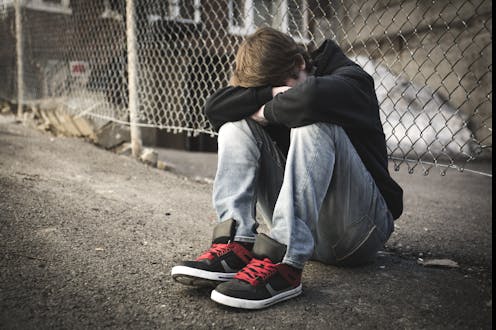
Suicide rarely happens in the absence of severe mental health problems. Research indicates that psychiatric disorders are prevalent in up to 90% of adolescents who die from suicide. In particular, what are known as affective disorders, such as major depressive disorder and bipolar disorder, are present in 44%-76% of cases.
This means that severe mental illness is the most influential and preventable predictor of death by suicide.
Bipolar disorder is a serious mental health condition characterised by recurring, alternating episodes of elevated (manic) and depressed moods. It underlies roughly 5% of all suicides among young people.
The majority of adults with bipolar disorder start having mood symptoms in their youth. But there is often a long delay between the onset of symptoms and correct diagnosis and treatment.
So the question is whether this gap puts vulnerable young people at risk of suicide. Our new research, published in in JAMA Psychiatry, hints this may be the case. We found fewer suicides among boys in Swedish regions with more bipolar diagnoses.
National registry data suggests that severe mental disorders in Swedish adolescents are unequally recognised and treated in general. And despite national treatment guidelines advocating for their use, our reserach appears to suggest that major academic hospitals do not consistently prioritise evidence-based treatments such as the mood stabiliser lithium or electroconvulsive therapy for adolescents.
Conversely, smaller counties with hospitals that are not affiliated with universities seem to be leading providers of such treatments.
These findings suggest there is a potential gap in knowledge regarding the diagnosis and treatment of severe mental illness in youth at Swedish universities. And such unequal access is likely to exist in many places beyond Sweden.
Importantly, we recently demonstrated that Swedish regions with higher implementation rates of evidence-based psychiatric treatments in Swedish 15-19-year-old males also had substantial reductions in excess suicide deaths in adolescents.
This indicates that early diagnosis and treatment for severe mental illness may be key for successful suicide prevention in male adolescents across the world.
Bipolar diagnosis
We know that the onset of bipolar disorder in youth is associated with more recurrences, greater rates of substance abuse and a greater likelihood of suicide attempts and violence. But there are good treatments, with lithium being the most effective at reducing suicide in adults.
Treatments for adolescents have been less researched. There is compelling evidence that lithium is associated with decreased suicide attempts, less depression and better psychological and social functioning, compared to other mood-stabilising medication.
However, the specific potential for lithium treatment to prevent suicide deaths in adolescent bipolar disorder has not been extensively investigated.
Despite retrospective studies showing that more than half of adults with bipolar disorder experience their first mood disorder symptoms before 18, practices of diagnosing the disorder in youth have been controversial. Doctors may be hesitant to diagnose and treat youth in case they are wrong.
There are also indications of widespread clinical misattribution of severe mental illness symptoms to alternative causes, such as autism, obsessive-compulsive disorder or pediatric acute onset neuropsychiatric syndrome (Pans).
International clinical guidelines therefore have different recommendations for the diagnosis of bipolar disorder. For example, the UK’s National Institute for Health and Care Excellence guidelines posit substantially stricter criteria for diagnosing bipolar disorder in adolescents than in adults. It requires the presence of mania) for a diagnosis, which isn’t always a symptom at the start.
This isn’t the case for the American Academy of Child and Adolescent Psychiatry. It recommends sticking with the standard classification system, the Diagnostic and Statistical Manual of Mental Disorders (DSM), for both children and adults.

We know that early pharmacological and non-pharmacological treatments for bipolar disorder have been shown to be effective in improving long-term outcomes.
But effective treatment relies on a correct diagnosis. And this is often delayed for bipolar disorder. In fact, research suggests an average time to diagnosis is about 6.7 years from disease onset.
New research
Our latest reseach was based on cross-sectional Swedish national registry data covering the years 2008–2021. This included 585 confirmed suicide deaths.
There were substantial regional variations. Some regions reported rates up to six times higher than the national average, while others did not report any cases at all. Notably, 87.5% of the regions with the highest diagnosis rates were not affiliated with medical research universities.
Among the university-affiliated regions, Uppsala stood out by diagnosing approximately five times more adolescents with bipolar disorder compared to other major Swedish regions such as Stockholm, Gothenburg and Skåne.
We demonstrated that regional diagnosis rates of bipolar disorder in adolescent males were strongly linked to lower suicide death rates – about 4.7% lower than the national average. Psychiatric care and the prevalence of depression and schizophrenia rates, on the other hand, had no impact on suicides.
This association could not be confirmed in girls. This could be down to statistical problems or the potential widespread misdiagnosis of bipolar disorder in females. Female adolescents were about three times more often diagnosed with bipolar disorder compared to males. And males were also nearly twice as likely to die by suicide.
The picture of how to prevent suicide in young people is becoming increasingly clear. Not only have we shown that evidence-based treatment can help prevent suicide young people, but now also that early diagnosis of bipolar disorder may play a role. This is probably data that health authorities across the world needs to take seriously.
There may be more insights soon. Our research group remains committed to investigating the full extent and consequences of health inequities in the diagnosis and treatment of youth with severe mental illness.
The authors do not work for, consult, own shares in or receive funding from any company or organization that would benefit from this article, and have disclosed no relevant affiliations beyond their academic appointment.
This article was originally published on The Conversation. Read the original article.







